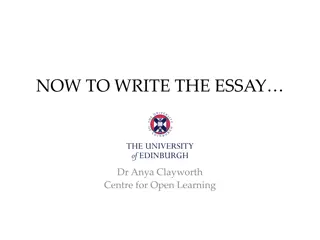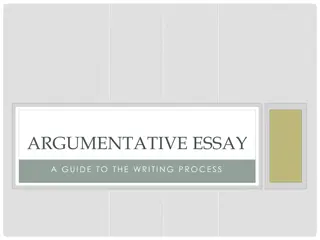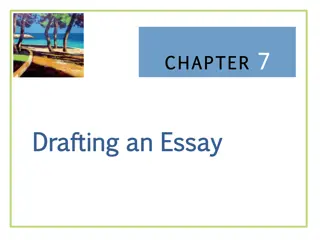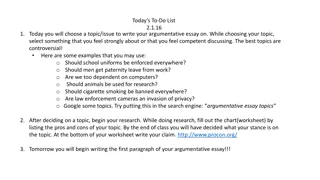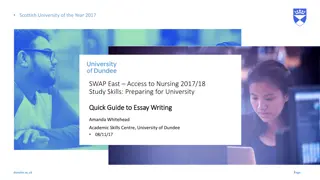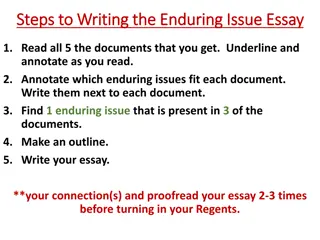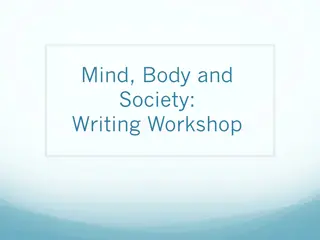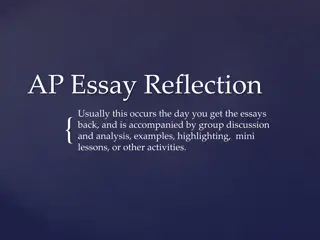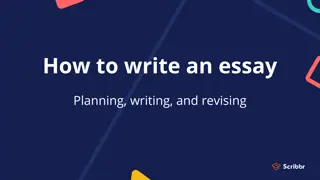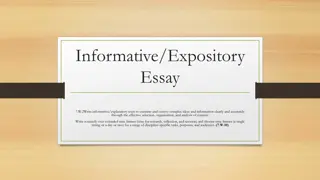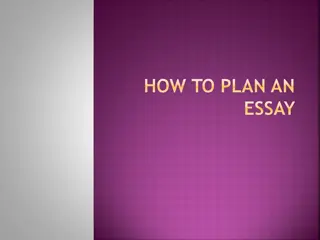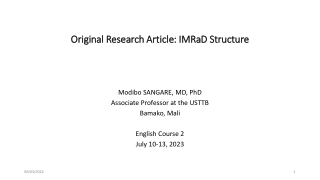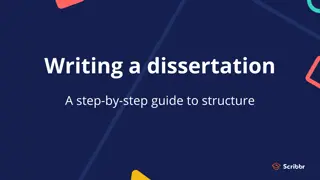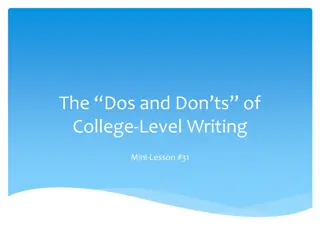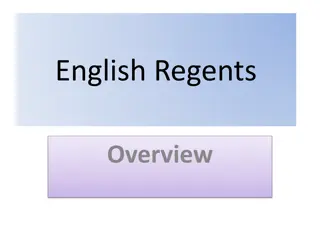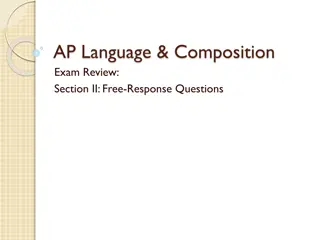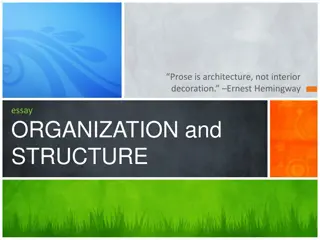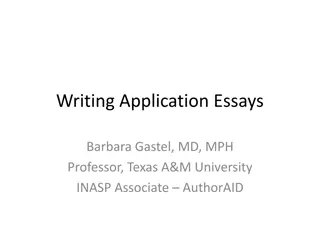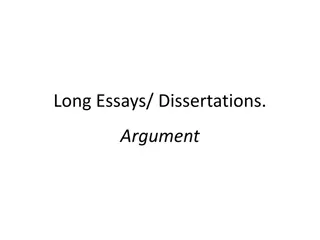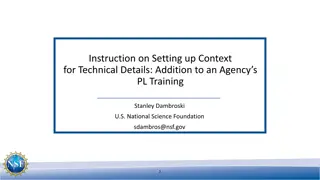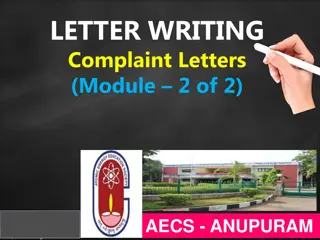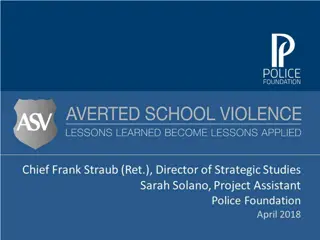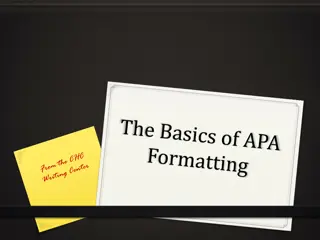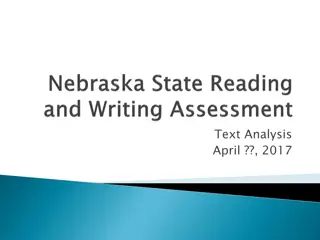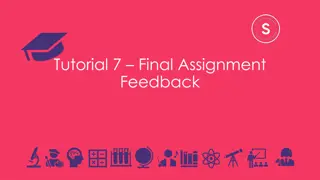Effective Tips for Structuring Your English Essay
Ensure your essay stays focused by reading the question carefully and planning your points beforehand. Avoid straying off-topic, use the PEAR structure for quotes, and always refer back to the question to maintain direction.
Download Presentation

Please find below an Image/Link to download the presentation.
The content on the website is provided AS IS for your information and personal use only. It may not be sold, licensed, or shared on other websites without obtaining consent from the author. Download presentation by click this link. If you encounter any issues during the download, it is possible that the publisher has removed the file from their server.
E N D
Presentation Transcript
Always read the question carefully, considering both parts Underline key words you will use from the beginning your essay right through to the end. The starting point of your essay should focus on the question, not the text you have studied. both parts. key words from it that beginning of right through to the end.
Plan your essay at the top of your page or on a spare bit of paper. It s a good idea to write down key points you want to make, key quotations, a structure and anything else you find helps you.
Planning helps you avoid: Remembering a point later on that you wish you had included Mentioning everything you know first then having nothing to write space it out! Stating in your introduction that you are going to follow a certain line of thought but then your discussion gradually moves away from this
Focus on the question straightaway Refer to key words in the question Give an outline of your intention in the essay (what will you be focusing on/what will your line of thought will be) Mention title and author Avoid including detail or examples but simply take a general overview of the question
If you feel you do need summarise a part of the story, then do so in your introduction. DO NOT take a new paragraph and begin to tell me all about the story/poem/play.
Use PEAR If you have more than one quote in a paragraph, then make sure you structure it like this: Topic sentence (point) Quote 1 + Analysis Quote 2 + analysis Relate to question at the end of the paragraph PEAR
Remember: At the start of every paragraph, refer back to the intro to check you re still on course and you haven t went off in another direction Do not begin paragraphs with detailed points but instead general topic sentences. Remember:
Example In chapter one we realise Old Major is in charge of the farm. Example In chapter one we realise Old Major is in charge of the farm. INSTEAD INSTEAD We are aware of the power structures on the farm in the first chapter. We are aware of the power structures on the farm in the first chapter.
Topic Sentence We are aware of power structures on the farm in the first chapter. It is evident that a hierarchy between the animals exists, with Old Major sitting on a raised platform and the dogs and pigs sitting immediately in front of him in the barn. By describing the animals sitting in this way, Orwell signals the way in which, despite efforts at equality, the pigs and dogs will later assume the dominant roles on the farm. Quote (Evidence) Analysis
Return to your introduction and summarise over the course of your essay. While you will be referring back to your original points, try to vary your word choice sound too repetitive. summarise what you have proved vary your word choice so it doesn t
Check your spelling is correct Particularly make sure you have spelled the author s name correctly and the characters/settings Check your punctuation is correct Make sure you haven t allowed two sentences to run into each other using a comma where you should have used a full stop. Read your sentences back if you run out of breath, it s too long! author s name correctly, the title characters/settings. title correctly
Using linking words and phrases help your writing flow There are essentially four kinds.
1. Adding on a similar point 1. Adding on a similar point Furthermore Moreover In addition to this Similarly Furthermore Moreover In addition to this Similarly
2. Making a different point 2. Making a different point However Nevertheless On the other hand In contrast to this However Nevertheless On the other hand In contrast to this
3. Placing ideas in order of importance 3. Placing ideas in order of importance In particular More importantly Of greatest significance Above all In particular More importantly Of greatest significance Above all
4. Drawing a conclusion 4. Drawing a conclusion Thus Therefore As a result of this Consequently Thus Therefore As a result of this Consequently
Use a colon : to introduce them No longer than one or two lines They should illustrate a point not simply repeat it Example: It is clear she had no money: Katie was heavy skint. MAKE SURE YOUR QUOTATIONS ARE WORTHWHILE!
Try to avoid using I, my etc. Do not write in an informal tone = no slang expressions Do not use shortened forms (don t, won t, can t = do not, will not, cannot) Do not use abbreviations (such as e.g. and etc. ) Do not write out the number 1, always use one .
Try to refer to some critical terminology to boost your mark: Imagery Symbolism Tone Conflict Themes Climax Narrative viewpoint Dialect Structure Imagery Symbolism Tone Conflict Themes Climax Narrative viewpoint Dialect Structure


